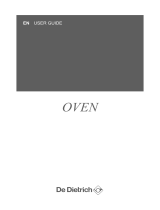e n g l i s h
Unpacking.
Remove all protective packing pieces.
Check and proceed according to the
appliance characteristics shown on the pro-
duct name plate (1.1.1)
1.1
Building in.
Use a unit of the correct dimensions (1.2.1). If it
is an open-back unit, the opening must be a
maximum of 70 mm . Centre the oven in the
unit so as to ensure a minimum distance of 10
mm between the appliance and the surrounding
unit (1.2.2).The material of the unit supporting
the appliance must be heat-resistant (or cove-
red with a heat-resistant material). For greater
stability, attach the oven to the unit with 2
screws through the holes provided on the side
panels (1.2.3).
1.2
2.1
Accessories.
Depending on the model, your oven is delive-
red with a standard tray (2.2.1) and a
2.2
Identify the oven model (
etc.) by comparing your appliance’s control panel
with the illustrations.
Fitting the accessories.
This oven has five positions for accessories
(shelf supports 1 to 5):
(2.1.1).
Identification
Installation
Use
wire safety shelf (2.2.2).
Ensure that the wire shelf, fitted with anti-tip
side stops, is correctly positioned (2.2.3).The
oven may be equipped with a rotisserie
(2.2.4).
To use it, place the standard tray in the bot-
tom shelf supports to collect the cooking
juices (or on the oven floor, if the joint to be
roasted is too large). Thread one of the forks
on to the spit, then skewer the joint, thread
on the second fork, centre the joint and
screw the two forks tight. Place the spit on
its cradle and push gently to engage the tip
of the spit in the square drive at the back of
the oven and then pull out the handle with an
unscrewing motion, so as to allow the door to
close. When cooking is finished, screw on the
spit handle once again, so that you can
remove the joint without burning yourself.
2.5
Immediate cooking.
The time must be displayed and must not be
flashing. Select the desired cooking function,
depending on the model (2.5.1); for this see
the Cooking Modes
table.
Your oven will suggest the best temperature
for this type of cooking.
You can still adjust the temperature up or
down using the temperature selection control
(+ or -) (2.5.2).
Place your dish in the oven, following the
recommendation given in the Cooking Guide
.
The oven will then heat up and the temperature
flashes. A series of beeps sounds, when the
oven has reached the selected temperature.
The display stops flashing.
Setting the time. Upon power-up, the flashing
display shows 12:00 (2.3.1).
Set the time by pressing the + or - buttons
(keeping the button pressed will cause the
numbers to scroll quickly) and then press the
clock button to confirm (2.3.2).
2.3
2.4
Resetting the time. The function selector
must be set at 0.
Press the button for a few seconds until
the display flashes (2.4.1) and then release
it. Beeps sound to indicate that the setting
may now be changed. Adjust the time using
the + and - buttons and then press the clock
button to confirm (2.4.2).
NOTE
: If the clock button is not pressed to
confirm, the setting is saved automatically
after a few seconds.
2.6
Programmed cooking.
Immediate start and programmed time.
Choose the desired cooking mode and set the
temperature. Press the button until the
Electrical connection. The oven must be
plugged in using a standardized power cable
with 3 conductors each 1.5 mm² (L, N + E)
which must be connected to the 220~240
Volt network by means of a standardized IEC
60083 power socket or a single-pole cut-off
device in compliance with installation regula-
tions. The safety wire (green-yellow) is con-
nected to the appliance's ground terminal
and must be connected to the installation's
ground lead. The installation’s fuse must be
rated at 16A.
We will not be liable for any accident or inci-
dent resulting from a non-existent, defective
or incorrectly connected earth, nor in the
event of a non-compliant connection.















